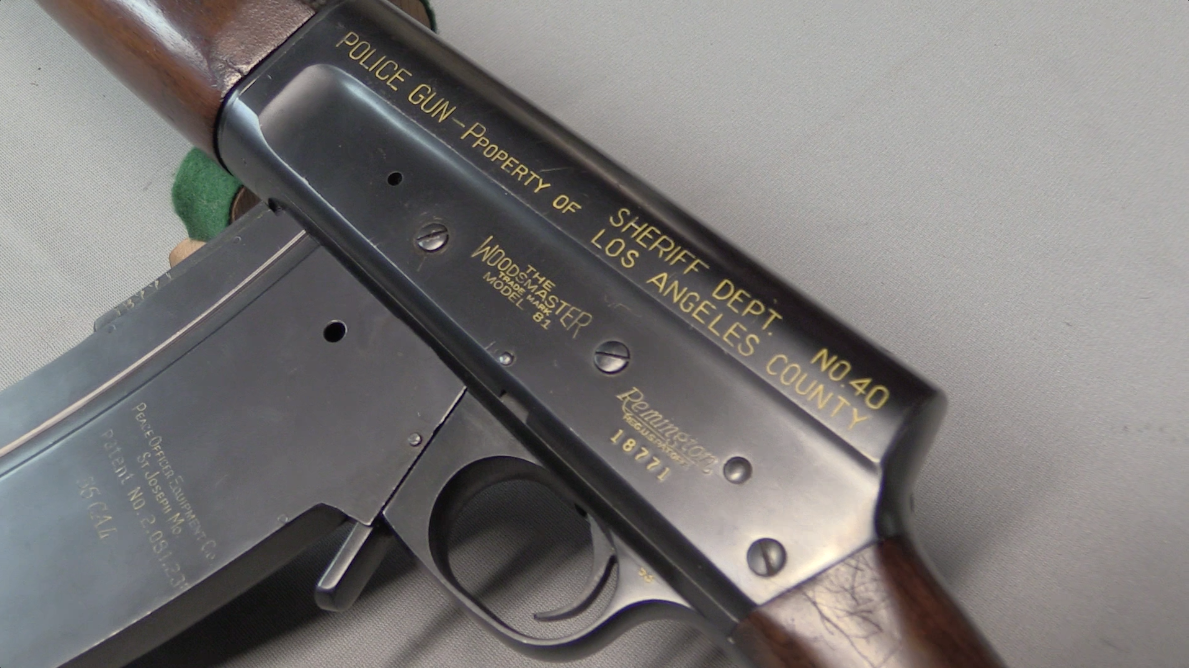Lot 3074 in the September 2019 RIA auction.
This appears to be a handmade prototype form one P. (or J. P.) Percy of Albany, NY, although I don’t have any information about who he was or when he built this. The gun itself is a .44/.45 caliber rimfire rifle, with three triggers. The first is actually a latch to release the tip-up barrel, and the other two and a sort of set trigger system. Inside, the whole trigger assembly is built as a removable unit, which is pretty interesting to see.



Maybe you should have a look at US patent 39494 in the name of John Percy, dated 1863. The drawings are not on the Internet but the description neatly fits. Regards, Bas Martens
Thank you for the patent. One thing that had me baffled was the firing pin not retracting when the breech is opened, the fired case removed and a live round chambered. If it was then closed briskly… The patent states that the gun should be cocked before attempting this.
It seems the gun was intended to be waterproof, and the patent claims mention a diaphragm but with no picture available, it is tough to tell. Given the early date and the proof of concept idea behind this gun, you can judge how appropriate a safety might be. Perhaps a mud test is in order 😉
Here’s the link;
https://patents.google.com/patent/US39494
John Percy, Albany NY.
It’s possible that the “P Percy” was an accidental double-stamp of the first letter.
The overall structure is much like the Frank Wesson rifle;
https://www.youtube.com/watch?v=zdzMJI3PPlQ
Percy may have tried to sell this to Wesson in 1863 as an improvement on the 1859 Wesson patent. It most likely chambers the .44 Long Allen/Wesson rimfire cartridge, .44 Short, or .44 Henry, since those were the only such cartridges in production at the time.
Note that there were no American-made .45 rimfires; the next step up from the .44s were the .46 caliber Ballard and etc. introduced after the end of the Civil War.
cheers
eon
Hi Ian,
I think you are off on when rim fires were superceed by center fire by a few decades. Henry’s were introduced during the later part of the civil war and by the early 1870’s center fire had taken over. Great firearm for us to examine via Forgotten Weapons.
Jim Kelly
Great steampunk styling, but an incompletely thought-out action, in that it lacks a mechanical safety and, as noted above, very likely would fire if closed uncocked on a live round. Percy could, of course, have engineered a rebounding firing pin, or perhaps linked the hammer to the locking mechanism so that opening the action would set a half-cock. Or something clever; he must have been a fairly inventive hombre, and I think it’s a dang shame he never found a backer. And let’s not tsk-tsk over the rough cold-chisel work inside the receiver. If his design could survive such crude fabrication and still work, that’s to his credit.
Let’s face it, this is a prototype and Percy just didn’t have the time to put the item through a field-test to make sure it was idiot-proof. Without money, tooling, and materials, the guy couldn’t continue development.
The J and NY stampings also puzzle me. Were they the work of a previous collector, perhaps when collecting standards were different? So many rabbit holes to ponder.
Maybe someone can answer a question for me. I have always been interested by the late 19teenth century cartrige arms where the metallic wrist of the stock and the receiver form a one smooth piece ie curve into one another.From memory there is the Evans lever action the Whitney Howard single shot the Barnekov Greene and now the Percey Another example would be the Colt first model deringer
I presume that the parts were moulded and then the surface machined. Was this style ie. one piece receiver and wrist done for the esthetics or because it was easier to mould then machine?
How was the rough molded surface then finished by machine or by hand? Hope someone can help
What interests me most about this rifle is the stock. From what I can see in the video, It appears the brass receiver, wrist, and stock all seem to be one piece. It looks like the wood is just two thin pieces screwed one to each side of the brass frame. It is very visually appealing to me. Thanks for another excellent video Ian!!
I have been a muzzle loader since 1969 and some of my favorites are Southern Mountain Rifles. Many of these firearms have extremely long tangs and toe plates. It looks like this may be the case with this rifle to the extreme. Or, it could be a brass casting with wooden panels. I just rewatched the video and I do see two screws on the right panel which would indicate that they are wooden panels attached much like pistol grips.
Take that, Tokarev and Petter!
The patent description at https://patents.google.com/patent/US39494 has 11 references to a “hammer” including 2 to the “inclosed hammer” so I think it refers to a different mechanism than the rifle in the current video.
Your article is very useful, the content is great, I have read a lot of articles, but for your article, it left me a deep impression, thank you for sharing.
Your article is very good, I have read many articles but I am really impressed with your posts. Thank you, I will review this article. To know about me, try talking to me.